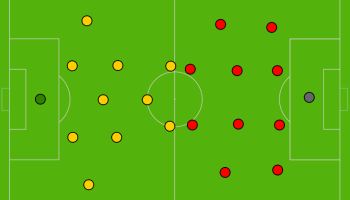The exciting moment comes at the end of a training week and you wish to pick your team, ready for the game ahead.
Before we discuss the formation, we really need to understand what it actually is? Traditionally the formation is the arrangement of players that will take the field in that given game. The ‘shape’ is announced and with it, players given a specific position to fulfil this ‘structure’.
From previous experience (coaching, management and an avid watcher of games), I’ve witnessed the following, that could be falsified;
The formation is often announced without a goalkeeper – “Today we’re playing 4-3-3”
It’s only mentioned in 1 moment of the game, usually in what it would look like while attacking
The formation has been picked before the players are considered. Thus ‘forcing’ a player into a certain position
Using a rigid format can take decision making away from players, as they may feel that they have to stay in a certain part of the field
There isn’t much emphasis of when the team, doesn’t have the ball
While all the above isn’t exclusive to a certain team, or a full accurate measurement of every coach, formations could be somewhat misunderstood.
When selecting a formation to use in your game, it could be wise to consider the following first;
The playing ability of your squad and that of the starting eleven – Understanding what your players are/are not capable of, should be analysed first. This then gives you a firmer starting point and an idea for what’s next….
Team intentions – This is the application of your team and how they will try to do something. This is their ‘intention’, when they’re defending, attacking or transitioning. By doing this, you can narrow down the decisions of the players – thus meaning a higher chance of getting one correct – and it can allow your team to be more predictable (better communication)
After this, the formation can be introduced to the team….
The formation is a tool in order to help the team intentions come to life. If you had a team intention of depth before width, more specifically – passing the ball long into the no.9, who is only 5ft 4”, while playing a deep 1-4-5-1, you may struggle to gain success. So, firstly you need to ensure that the team intentions align with the playing personnel that you have at your disposal, followed by a formation that could allow more chance of this happening.
During match play, it is safe to say that the formation will change almost, immediately. This could be due to both attacking and defending intentions of the team, as well as the position of the ball. So why are formations given a higher element of focus?
When selecting the team, coaches could be concerned of what spaces will need defending and which ones will need exploiting, when attacking. Or, it could be the fact that ‘choosing’ a formation is easy and used with a subjective starting point. Taking into consideration of what spaces will need attention is important, but it shouldn’t be treated as an objective in itself.
The overall objective of the game is to score at least 1 more goal than the opponent and take victory, so the formation is only a tool, in order to help you in achieving this.
To conclude maybe consider the following when you’re preparing for your next game;
Player abilities > tactical intentions > team formation.


